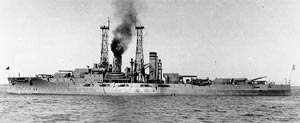USS Delaware (BB-28)
|
|
 USS Delaware
USS Delaware | |
| Career | Missing image USN-Jack.png United States Navy Jack |
|---|---|
| Laid down: | 11 November 1907 |
| Launched: | 6 February 1909 |
| Commissioned: | 4 April 1910 |
| Decommissioned: | 10 November 1923 |
| Fate: | sold for scrap |
| General Characteristics | |
| Displacement: | 20,380 t |
| Length: | 518' 9" |
| Beam: | 85' 3" |
| Draft: | 27' 4" |
| Speed: | 21 knots |
| Complement: | 933 officers and men |
| Armament: | 10 x 12-inch guns, 14 x 5-inch guns, 2 x 21-inch submerged torpedo tubes |
The sixth USS Delaware (BB-28) of the United States Navy was a battleship launched in 1909 and scrapped in 1924, the lead ship of the Delaware class.
Delaware was launched 6 February 1909 by Newport News Shipbuilding Company, Newport News, Virginia; sponsored by Mrs. A. P. Cahall, niece of the Governor of Delaware; and commissioned 4 April 1910, Captain C. A. Gove in command.
After visiting Wilmington, Delaware, from 3 to 9 October 1910, to receive a gift of a silver service from the state, Delaware sailed from Hampton Roads 1 November with the First Division, Atlantic Fleet, to visit Weymouth, England, and Cherbourg, France, and after battle practice at Guantanamo Bay, Cuba, returned to Norfolk, Virginia 18 January 1911. She departed 31 January to carry the remains of Chilean Minister ? Cruz to Valparaiso, sailing by way of Rio de Janeiro, Brazil, and Punta Arenas, Chile. Returning to New York 5 May, she sailed 4 June for Portsmouth, England, where from 19 June to 28 June she took part in the fleet review accompanying the coronation of King George V.
In her operations with the Fleet from 1912 to 1917, Delaware joined in exercises, drills, and torpedo practice at Rockport and Provincetown, Massachusetts; engaged in special experimental firing and target practice at Lynnhaven Roads; trained in Cuban waters participating in fleet exercises; and provided summer training for midshipmen. She passed before President Taft and the Secretary of the Navy in the Naval Review of 14 October 1912 and the next year visited Villefranche, France, while on a cruise with battleships Wyoming (BB-32) and Utah (BB-31). In 1914 and again in 1916 she cruised off Veracruz to protect American lives and property during the political disturbances in Mexico.
With the outbreak of World War I in Europe, Delaware returned to Hampton Roads from winter maneuvers in the Caribbean to train armed guard crews and engineers, as well as join in exercises to ready the Fleet for war. On 25 November 1917 she sailed from Lynnhaven Roads with Division 9, bound for Scapa Flow, Scotland. After battling bad weather in the North Atlantic, she joined the 6th Battle Squadron, British Grand Fleet 14 December for exercises to coordinate the operations of the Allied force.
The 6th Battle Squadron got underway 6 February 1918 with an escort of eight British destroyers to convoy a large group of merchant ships to Norway. Cruising off Stavanger 2 days later, Delaware was attacked twice by a submarine, but each time skillful handling enabled the battleship to evade the torpedoes. The squadron returned to its home base at Scapa Flow, 10 February. Delaware participated in two more convoy voyages in March and April, then sailed with the Grand Fleet on 24 April to reinforce the 2nd Battle Cruiser Squadron which was on convoy duty and expected contact with the enemy. Only the vessels of the advance screen made any contact, and the chance for action faded.
From 30 June to 2 July 1918 the 6th Battle Squadron, with a division of British destroyers as escort, went to sea to screen American ships laying the North Sea mine barrage. On 22 July George V inspected the ships of the Grand Fleet at Rosyth, Scotland, and 8 days later, after being relieved by Arkansas (BB-33), Delaware sailed for Hampton Roads, arriving 12 August.
Delaware remained at York River until 12 November 1918, then sailed to Boston Navy Yard for an overhaul. On 11 March 1919 she joined the Fleet in Cuban waters for exercises. Returning to New York 14 April she continued to operate in division, squadron and fleet maneuvers, and participated in the Presidential Fleet Review at Hampton Roads 28 April 1921. She made two midshipmen practice cruises, one to Colon, Panama, Martinique, and other ports in the Caribbean, and to Halifax, Nova Scotia between 5 June and 31 August 1922; and a second to Europe, visiting Copenhagen, Greenock, Cádiz, and Gibraltar between 9 July and 29 August 1923.
Delaware entered Norfolk Navy Yard 30 August 1923, and her crew was transferred to Colorado (BB-45), a newly commissioned battleship assigned to replace Delaware in the Fleet. Moving to Boston Navy Yard in September, she was stripped of warlike equipment and decommissioned 10 November 1923. Delaware was sold 5 February 1924 and scrapped in accordance with the Washington Treaty on the limitation of armaments.
External link
- Navy photos of Delaware (BB-28) (http://www.history.navy.mil/photos/sh-usn/usnsh-d/bb28.htm)
This article includes text from the public domain Dictionary of American Naval Fighting Ships.
| Delaware-class battleship |
| Delaware | North Dakota |
| List of battleships of the United States Navy |
